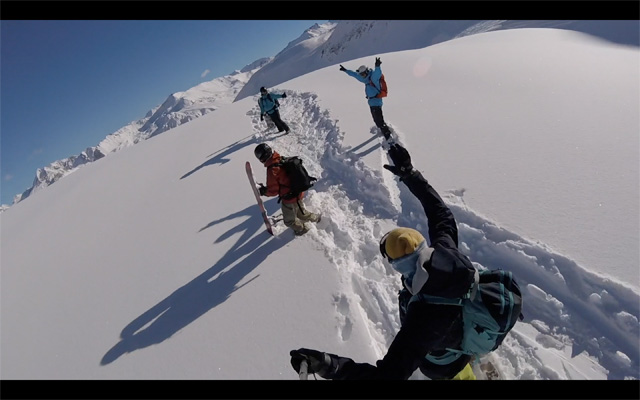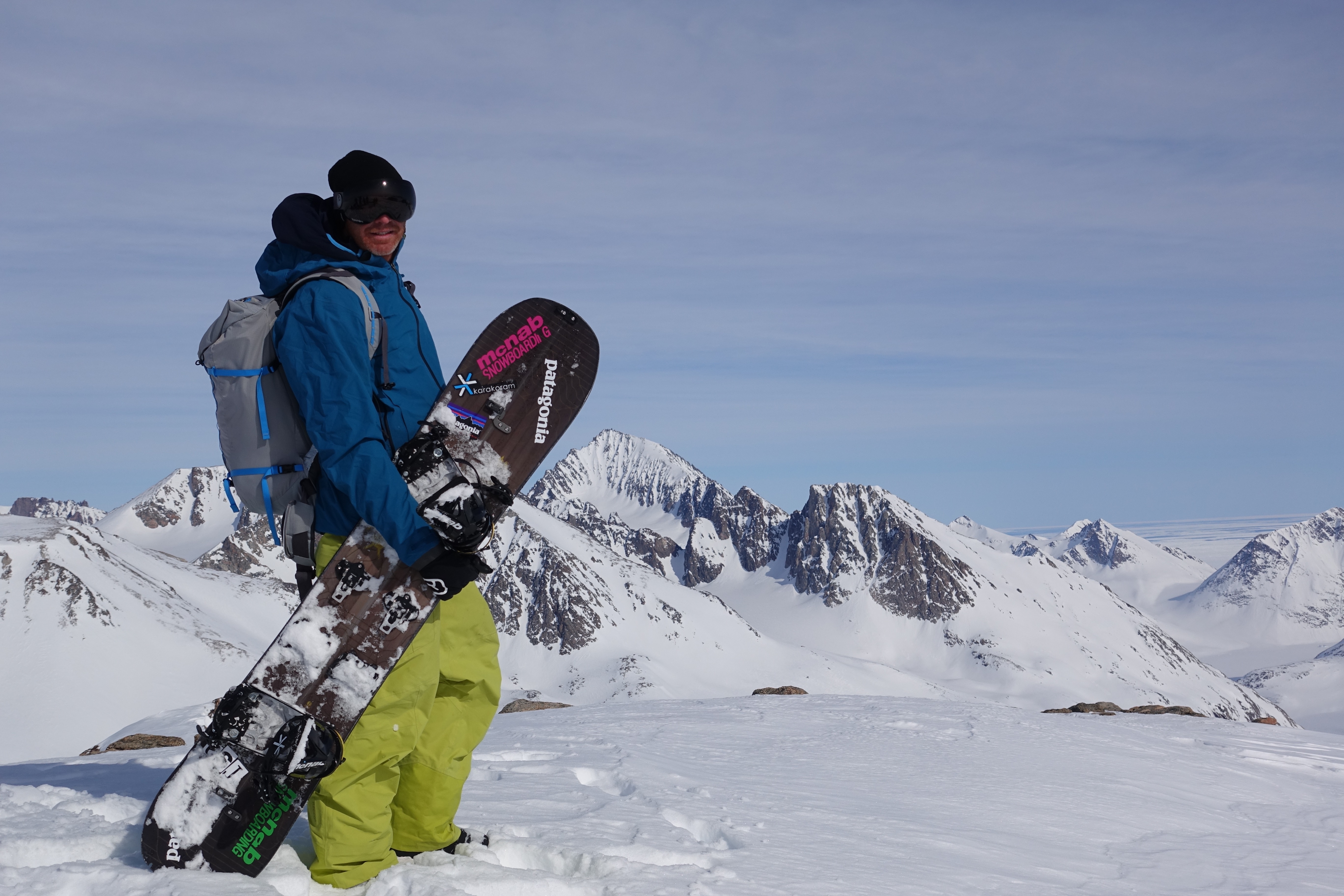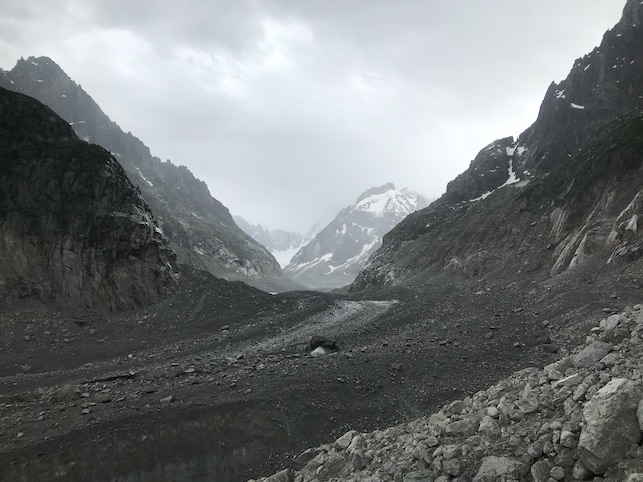
A Mountain Guides perspective to Climate change in the high mountains.
When I looked out of the windows of my new home in the Chamonix Valley in 1995, I was over awed by the vista of high peaks and glaciers that filled my view. The Bossons Glacier stretched down into the tree line of the valley floor like a huge lizards tongue snaking downwards from the ‘land of Dragon’s above’. The Argentiere Glacier, opposite my window, still connected to the glacial basin above, also reached down to the valley, filling the depths of the deep sheer sided gorge below, the Glacial ice easily accessible a short walk from the ‘Cremerie’ restaurant situated in the woods at the foot of the gorge.
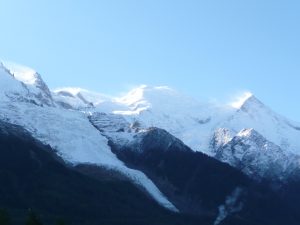 Les Bossons glacier still quite low in the valley in 2007
Les Bossons glacier still quite low in the valley in 2007
At the time, mid 90’s, the glaciers seemed permanent, more permanent than our dwellings and our lives below them. This powerful element of nature seemed like it would always be. Stories from the past of the glaciers growing in depth and length, threatening the residents of the villages below still seemed like a real possibility. On this day, the shear size and depth of the glaciers cast a cold air over the valley and our existence below them seemed fragile and threatened. I was in awe!
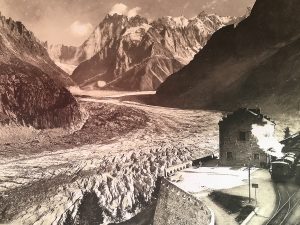 The Mer du Glace late 1800’s pre industrial warming
The Mer du Glace late 1800’s pre industrial warming
During my first years living in the Chamonix valley I slowly explored and pushed my boundaries outwards towards the higher peaks that surrounded my life. Still in awe and overwhelmed by the high mountain environment I stepped cautiously forwards, testing my footing step by step. The Mountains required respect and to walk and climb amongst them was a privilege that needed to be earned.
I remember my first forages out into the cold shaded ice filled basins of the high glaciated valleys. The overpowering sense that I shouldn’t be there, that this was sacred space. The dark North faces, the conquests of which I’d read about in books towering overhead. The jagged rocky shards of the peaks pearcing upwards like knives into the cold clear space above, sunlight catching their tips and illuminating the snow being stripped from them and cast high into the air by the cold winds blasting, shaping and sharpening their razor sharp granite blades.
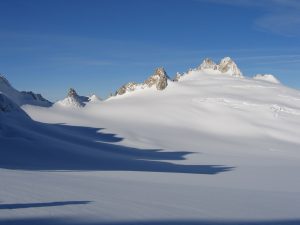 The Trient Glacier before the dissapearence of the perma snow.
The Trient Glacier before the dissapearence of the perma snow.
I remember the snow beneath my feet seeming permanent and historical. I felt like I was walking, climbing and riding on a past that would never change. The routes I followed weaved their way through crevasses, up rock and ice walls and around seracs that had gaped and stood for millennia. This was a cold powerful place, not a place for human existence, where even in summer the cold frigid air seeped from the black holes of ancient glacial ice and flowed down from the peaks above to pool in the valley below engulfing you in its cold icy grip, lingering where the sun would never reach.
Little by little I explored and developed my understanding of this icy world. I ventured out to test my ability and explore my physical capacity. In a world where I felt we shouldn’t be, it was easy to find demanding new experiences and find yourself tested beyond reason. The comforts of the world below had no meaning up here. Here I could explore my physical and mental limits on a daily basis.
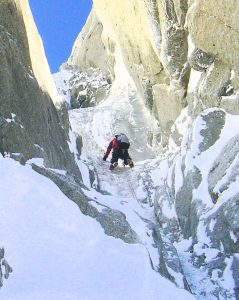 Exploring my boundaries
Exploring my boundaries
I would spend years fighting against these impenetrable elements, struggling and battling against the high Mountain environment, before, as I gained in experience, slowly realizing that success or survival could only come from balance and understanding, working with Nature rather than against.
I started to better understand and appreciate the shaded cold world above the valley that was now my long time home and made it my life goal to share the beauty of this World with other like minded soles, in turn introducing them to natures valuable lessons that only this cold world could teach.
After a while the Mountains became more familiar. I studied them and felt comfortable amongst them. They began to feel almost predictable and I could recognize and work around and with the ever changing elements. I had found my place and I based my life and career amongst them, earning victories and acclaim as a Climber, Skier and Snowboarder and recognition as a fully qualified International high Mountain Guide. With time, the bite of my crampons in the summer reassured me and began to feel like home. The cut, slide and carve of my edge in the winter filled me with joy of unwritten potential. This was my life, my career, my passion. Winters were seasons of deep snow, summers were seasons of blue skies, steep rock walls and sun lit summits. Still high up above the valley, both Summer and Winter, it was always cold and imposing, but I had learned and become accustomed to this high Mountain environment that I assumed would never change.
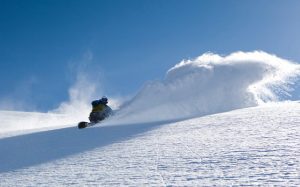 Becoming familiar with the mountain playground
Becoming familiar with the mountain playground
When I first guided the valley Blanc in the winter, sometime around the year 2000, it was a beautiful blue skies powder day. Roped and crampons for the long narrow, airily exposed ridge that leads down from the mid station to wide snowy shoulder below. Find space amongst the other guided groups here for the change to Snowboards. Cold wind, air full of cold windblown snow and then fresh tracks down the Petite Envers. No wind, good riding, some steeps, a few narrow snowbridges, some deep dark holes to go around, amazing views of golden granite towers and snow whiter than white. A quick stop at the Requin refuge and onwards and downwards towards the Mer du Glace. Traverse over to the Montenvers lift, still level with the glacier at this time or ride down further until a short walk up to Mottets for the descent that leads all the way to Chamonix.
Summers were filled with cramped sleepless nights in small wooden mountain huts, 2 am headlight lit starts. The cold crunch of crampons on snowy approach below a star lit sky, the scrape of crampons on rock, the bite of ice. Duvet jackets and warm down mitts, warm over trousers, big warm mountain boots and quick cold photos on freezing windswept summits. It was cold and it was extreme, it was as it should be.
 The cold snowy days of the past.
The cold snowy days of the past.
I didn’t really notice the permanent changes at first. Climate change and global warming slowly became phrases or labels associated with snow scarce winters, but I honestly expected the good times to return. January became drier and drier, cold crisp days spent riding on early winter snow that had fallen in November or December. At night when the temps dropped the snow cannons ran constantly, the lower slopes cold and bare, except for the man made snow always making it possible to ride to the valley at the end of the day as we waited and ‘made do’ until the big winter snows of February and March.
And we waited!
Feb, March spent watching the forecasts. The whole valley waiting in anticipation of the big dump. The snow would come and were as before there’d always been enough for everyone, now the queues would form before first light and the last of the fresh snow would be tracked before midday. Tension creeps into the ever growing winter crew as the wait continues.
The ‘few’ start to venture further out, chancing and dancing amongst the steeps in a form of downhill mountaineering which spreads like electricity amongst the pack. Boundaries are moved, as the few push outwards the pack creep forwards, following in their shadows.
The space formerly reserved for the experienced mountaineer quickly becomes the playground known as the Backcountry, the original Backcountry is now the Slackcountry and the resort boundaries and ‘Off Piste’ have faded.
What was once for the few is now the terrain of the masses. Confidence is building, the lack of snow makes things predictable again, the snowpack is stable, long mild days, clear skies, the limits can be pushed.
But now the snow comes, not spread out over the winter like before, but in short sharp bursts. Large dumps of snow with very strong winds, windblown snow on a solid sun affected base. The temperature rises dramatically, rain now falls in the valley, snow up high, wet with strong winds. Its changing so fast we can’t keep up.
The pack are hungry, they’ve been waiting, been exploring, building their confidence in areas of the mountain that weren’t accessible, but now maybe are? When the inbound is tracked, the pack will move outwards. Confidence is building and they’ve bought equipment to boot. The race for fresh lines is on.
The snowpack becomes predictably unpredictable with windblown snow sitting on a thin, early season, cold crystalized base with a hard but breakable suncrust layer sandwiched in there. A name is given to this new phenomenon and the ‘persistent weak layer’ is born. Its not a good thing, no one really notices?
A few bad winters and we start to look further afield, maybe we need to travel to the snow, Japow calls to some, Canada seems good? The sense of adventure, the new confidence also leads some out into the unknown lands of the in-between. Georgia, Krygystan, all the stans, and the Arctic North calls us upwards. No lifts exist out here so its hiking or Heli. Most opt for a long haul flight and a Heli or Snowcat. We’re still ignorant to its effect, but its starting to tease some, a quiet nagging at the back of our minds, but for now its all about personal gains and fear of missing out.
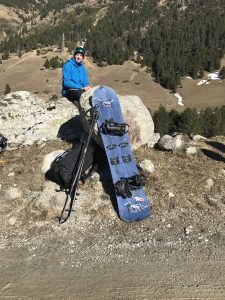 Finishing tours in snowless valleys is more and more common.
Finishing tours in snowless valleys is more and more common.
The winter snows melt fast in the summer. They’re less deep than they once were and the rising summer temperatures soon see them off. The permanent snows that cover the glaciers up high, hidden beneath the winter snows are exposed sooner to the rising summer temperatures.
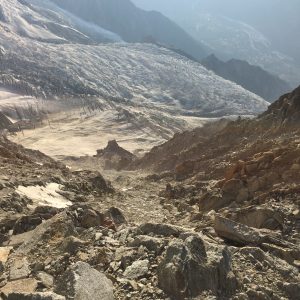 The cold air no longer descends, the rising heat is too strong
The cold air no longer descends, the rising heat is too strong
The cold air that once ran down the mountains into the valleys seems to be blocked by the warmer air rising upwards. The cold shaded glaciers seem warmer, warm air blows upwards over the ice filled valleys. Butterflies fly in panicked fashion as the warm valley thermals whip them up into the Oxygen starved air of the high mountains.
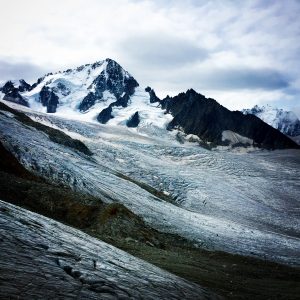 Once the Perma snow has gone the glaciers melt increases tenfold
Once the Perma snow has gone the glaciers melt increases tenfold
The Perma snow covering the Glacier is getting dirty, the warm air is bringing the pollution from the valley up higher and higher. The thick smog below is creeping, the irony of ‘clean mountain air’ is not lost on us but it’s a newish thing and it’s not all the time yet.
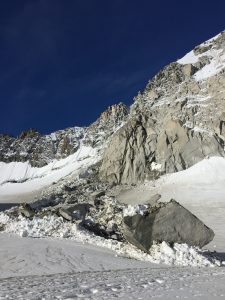 Rockfall becomes more common as the mountain melt around us
Rockfall becomes more common as the mountain melt around us
The dirty snow absorbs the sunlight and heat quicker. Its irreversible now, the perma snow is disappearing quickly. Some of the old classic snow routes through the high Mountains are becoming icy, rocks are appearing and also falling from the steep faces above as the ice melts from the granite towers and they become instable in the heat. Its not long now until some of the classics are, for the first time in history, impassable. As Guides, we’re suddenly faced with changing itineraries, not just because of bad weather, but also because of the conditions changing due to a warming climate!
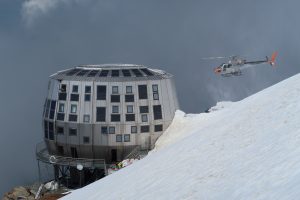 The new Gouter refuge sleeps 120+ people every night all summer
The new Gouter refuge sleeps 120+ people every night all summer
New refuges replace the old ones, they’re bigger and better. More people can come, work is a plenty, there’s work for all. The mountains are warmer, its more pleasant up there now. Big boots are swapped for lighter more comfortable ones, crampons get lighter and have string holding them together and the first lycra clad runners come skidding down the glacier from the summit of Mont Blanc in gaitered running shoes.
The changes seem to be getting more evident. Its seems that things aren’t going to go back to how they were. From the valley, were once I gazed upon the Icy tongues of the glaciers of les Bossons and Argentiere from my window, the Ice is now no more, replaced by deep dusty steep sided gorges gouged by the ice long gone.
I lead my group down the Midi ridge past the hay bails that have been thrown into the new crevasses appearing in the ridge as the ice melts from the warming rocks. The rocks never used to be here on the ridge, but now they provide a rock island that separates the upper and lower ridge. Normally in winter the ridge returns to snow, top to bottom, but not this season. The snow has been scarce. Its been scarce before, but not like this, this is even worse than last year. Last year was pretty bad, pretty scarce!
The shape of the glacier has changed, the thinner glacial ice hugs the contours of the mountain underneath. Before it was a sea of ice, now is a river of ice flowing between the rocky formations that were once covered and cliff bands have appeared here and there were before there was only Ice. The classics are changing, maybe the classics are no more!
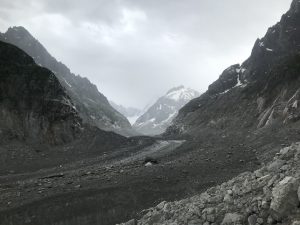 The dust and rubble of the Mer du Glace 2020
The dust and rubble of the Mer du Glace 2020
Further down the Mer du glace is just dust and rubble, we opt to walk rather than take our boards on and off to link up the patches of ice and melting snow between the melt water and rocky moraines. At the Montenvers (we can’t ride to Chamonix anymore) a new walkway has been built from the ‘glacier’ to last years new walkway, which was built to provide a link to the new steps, that lead up to the old steps that were built to link to the even older steps of the Montenvers lift, now found a couple of hundred meters (I kid you not) above the dusty rock strewn valley that is what’s left of the Mer du Glace. Plaques litter the walls above the steps to point out the level of ice loss from year to year. Just before the lift is the plaque for the year 2000. Looking down into the dusty valley below its hard to imagine that we came off the ice at this level when I first started Guiding this descent.
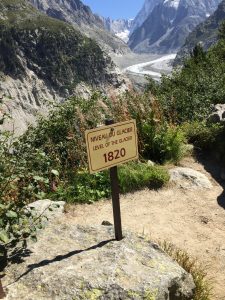 Hard to believe the level of the ice used to be up here 200 years ago!
Hard to believe the level of the ice used to be up here 200 years ago!
Fortunately they’re building a new lift as access to the new Ice cave that they are tunnelling into the now shallow Glacial Ice for the tourists to visit in the summer. The irony of these tunnels being carved into the receding millennia old Glacial ice is lost on most visiters, just happy to shelter in the cool of the ice tunnels from the searing heat outside. Soon maybe we’ll be able to walk up extended steps to this new lift from the rocky rubble of the dying Mer du glace.
The valley is getting so busy both summer and winter. Its choked with traffic. Cars circulate the choked roads, engines idling as they sit in long queues going nowhere fast. There’s nowhere to park, nowhere to go, the solitude of the high mountains is a crowded space.
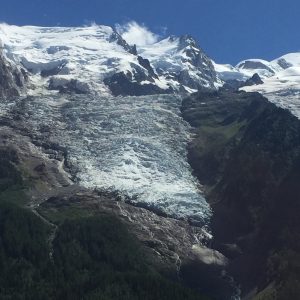 The Bossons glacier 2023
The Bossons glacier 2023
The queue for the tunnel through from France to Italy stretches down to les Bossons, to where the Glacial tongue used to be. The sign says it 2hours 30mins, but its longer. Cars and Trucks sit idling as they creep forward, one car length every few minutes.
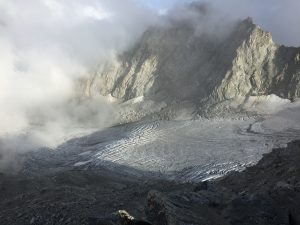 The melt continues both day and night
The melt continues both day and night
The air in the valley is hot, thick and dirty. The dirty air warms faster, the rising temperature of the valley reaches its fingers upwards high into the mountains. The Iso-therm reading of zero degrees C is above the summit of Mont Blanc and a mass of Paragliders circle like vultures over the summit trying to land and take off again. It’s the first time the Iso-therm has been high enough for this to happen and they’re very excited by it. I left the summit the day before, my first time up with out gloves on summit day! The following morning I have to wait a long time to cross the Grand couloir on the way down from the Gouter refuge, the night was warm and nothing has frozen. The rockfall has been constant all day and night for weeks now. As I wait for the rockfall to cease I watch a couple of Spanish climbers amble across the deadly space seemingly oblivious to the danger as one pauses to take a photo of his friend, neither of them have a rope on or crampons, but then I figure I’d also definitely not want to be tied to either of them as they slip and fall and rocks fly on by. Ignorance is bliss? That’s what they say and I must admit as I shelter in place with my clients waiting for a pause in the rockfall, to not be aware of the dangers we now face in the high mountains or off the changing climate must be pretty nice and somewhat calming. Hmmm, maybe there’s something to climate denial after all?
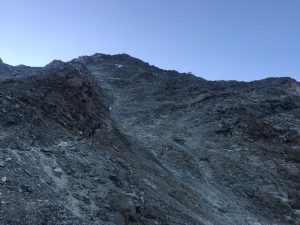 Looking up the dry dangerous Grand Couloir on Mont Blanc
Looking up the dry dangerous Grand Couloir on Mont Blanc
Ignorance is bliss but the changes are in our faces now and the mountains are unrecognizable to those that knew them before. It started slow but it was there to see. We thought it was temporary and then it just accelerated and now, to be honest and blunt about it, its just fucking shocking!
Another runner jogs past slipping about on the ice with his running shoes and 2 litre backpack. Maybe that’s the future? Are there more mountain running shops in Chamonix now than mountaineering shops? It must be pretty close. Thousands turn up to run around the mountains instead of climbing them, ironically, the local children are told to stop running at school and to stay in doors because of the tiny invisible particles now invading the atmosphere of the valley and considered a danger to their lungs.
The pollution levels of the Chamonix valley headline national news for the first, but not last time.
We recognize that its time for change! We need change, we need to turn this around or at least slow it down. Is anyone listening?
Change is inconvenient, we’ve been taught convenience is our right.
We start to recycle, we try to buy less, re-use and repair, we feel better for it.
Climate change is in our face, it’s on the news, it’s in our media. Somewhere is getting flooded, suffering drought, burned or blown away in violent Hurricane (that has been given a women’s name, perhaps given to make it seem more friendly and less violent).
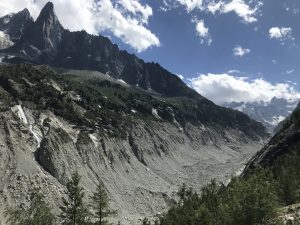 Where once was the Mer du Glace
Where once was the Mer du Glace
In the high Mountains time for change has already passed us by. We heard it coming, but didn’t recognize it. Temperature change affects the higher or cold climates first. Its where the effects are most evident, most severe, warming equals melting. Anything held together with snow and Ice will obviously be dramatically effected by rising temperatures where every 100m change in altitude gives an average temperature change of around 1C. As the valley temp rises, that rise in temperature gets pushed upwards into the mountains.
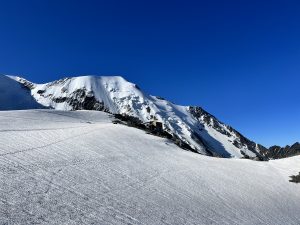 Final approach to the Tete Rousse Glacier a few years ago
Final approach to the Tete Rousse Glacier a few years ago
Polluted air warms faster than clean air. The dirty air rises fast, it coats the snow and ice with its soot and the melt rate increases two fold.
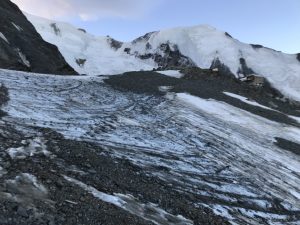 Approach to the Tete Rousse today…
Approach to the Tete Rousse today…
The cold air no longer seems to descend from above, the thermals are pushing higher and its getting windy up there too, it always so windy, the weather is changing.
The glaciers are melting faster than you would believe is possible. Where a few years ago we walked across glaciers outlined on our maps, today sometimes now there is simply mud, dust and rock. Our maps are out of date, they show glaciers where today no ice exists.
The Glaciers are the hydration bloodline of Europe, the water flows across the continent until it reaches the Ocean. It fertilises the land. The Glaciers of the Pyrenees once hydrated the fertile plateaus of Spain, the crop lands that today lie barren, dusty and dry! The glaciers here disappeared some time ago, it just took a while for the lands to dry out, rising temperatures probably helped but we noticed too late if at all. Many expect it to just be a glitch and that these once fertile lands will soon produce again, maybe for now water can be pumped in from elsewhere.
As winter enthusiasts, the lack of winter snow in the Alps makes us look further afield. Long haul flights to immense resorts with guaranteed snow making facilities, maybe a weeks heli ski, cat ski or touring. We make our booking, but at the end of the journey its too warm, it rains instead, it didn’t say this in the brochure.
We give it another chance, conditions are poor but it snows 20cm and we’re happy. Its not all bad, things are coming back. Back on track. Maybe, the more extreme climate might make things steep and deep again, we live in hope and record snowfalls hit in the US. We’re saved, but its not coming back, not in the predictable seasonal fashion of before.
A UK politician says the changing climate it’s a good thing, The Uk will be warmer, less people will suffer the cold. The UK Prime Minister reinvests in the fossil fuel industry that, to make any change, we need to phase out and an ex-US President says its all a Hoax and that the wind turbines are ‘killing the beautiful birds’ (he doesn’t seem the like the type to appreciate nature and also wanted to inject bleach but someone must have stopped him) his followers cheer, climate change is fake, in fact everything is fake!
The loudest voices seem to those in opposition, but in opposition to what? Cleaner air, natural energy sources, Nature, science?
“We’re fed up with listening to experts”, 52% of the UK vote to isolate themselves from their neighbours for the promise of a better life, more cash, better borders and less immigrant workers coming over from their war torn, drought ridden, climate affected, lands to nick all the caring for the ageing, NHS and farm labour jobs. It’s a close vote but a win is a win and a whole nation changes course on a 1.89% majority. The 48% that didn’t speak out search inwards, wondering how this happened as the lyrics of a long forgotten song spirals in the background, ‘the lunatics are taking over the asylum’ and Isolationism becomes a new word in our ever expanding vocabulary, out is out!
We’re cutting down the trees, in fact most of them have already gone and most of the rest are on fire, so now we’re cutting down the rain forests, millennia old woodlands and jungle, the heart and lungs of our natural world.
We’re destroying natures own perfectly designed carbon capture system in order to grow non indigenous crops, used to feed livestock halfway around the world to feed a population that for the most part don’t believe in climate change whilst contributing the most to it.
The new smaller areas of rain forests are loosing their ability to produce the moist climate needed to create the rain that gives them their name. We’ve destroyed the natural balance, the natural cycle is broken and soon maybe that land will also dry out and become dust.
The balance of nature is in turmoil but no one in power is interested, it seems there’s no money to be made in preserving our Natural world, only in rebuilding it as it burns.
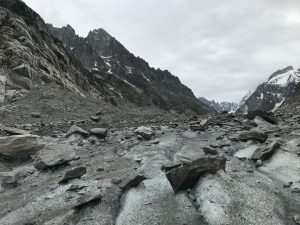 Tipping point in the mountains has passed long ago
Tipping point in the mountains has passed long ago
Are we at tipping point? Did our rising temperature calculations allow for the heating and carbon produced by our now burning planet?
If you look at an untouched space of true nature and compare it to what most of the habitable space of our planet now looks like, then you’d have to say that we have gone far beyond tipping point, adjusting natures balance to fit our needs or desires.
In most of the habitable world, the Natural balance of our planet is long gone.
Nature by definition – the physical world, including plants animals, the landscape and other features and products of earth as opposed to humans or human creation. Even our created definition of Nature excludes us.
The raw power of nature, the balance of existence is what attracted me to the world of the high mountains and has led me through my life. Anyone that has taken a moment to stand in natures fold, that has stood in silence, in awe, surrounded by our natural world can’t help but notice the imbalance of the world we live in. Areas of real nature are getting hard to find these days, the ground we walk on, the sounds we’re surrounded by, the air we breathe, even the light of our world is different, manufactured and unbalanced.
Healthy areas of our planet are green and humid. Here animal life is in abundance and plant life thrives. As our planet dries out, life begins to struggle, its plain to see. As a species we rely on water for our nearly everything. Without water life becomes a battle and perishes and yet we are watching our planet heat up and dry out. Of course, we now have Flash floods, extreme storm events were a years quantity of rain falls in one sitting onto an earth baked ground that can’t cope. It’s here today and gone tomorrow, chaos and destruction left in its path, the deep mud turns to dust and becomes airborne as the temperatures rise again.
Unless we start to recognize the importance of natures natural balance, then the future of our planet is not in good hands.
Where do we go from here?
Stopping our reliance on fossil fuels, the way we extract and burn them for transport and energy is a basic. We’ve all heard this line and whether we believe it or not, it is a simple fact that we need to gain our future sources of energy from more natural sources, if not only for the heating climate but for the polluted air we are breathing.
We already have the technology to make this a reality. We’ve had the ability to harness the sun, wind and tide since for ever, where I grew up on the bleak and windy North Yorkshire moors of the UK, way back in the late 70’s early 80’s, there already existed a wind turbine, harnessing the ever constant West wind, creating endless power for a local business.
This technology is not new, we just have to commit and implement it, in other words, the ‘powers that be’ have to work out how to make a profit from natural power that is larger and more politically powerful than the fossil fuels model.
It’s not difficult to see what stands in the way of progress when it comes down to powering our vehicles and homes.
Look at the technology that has gone into a mobile phone in the past decade and compare it to the advancements that have been made to the combustion engine that has existed, relatively unchanged, since the first car was invented.
Is it true that the great scientific minds couldn’t have come up with a better system after all this time?
I think back to my childhood 70’s and 80’s when an ‘electric Milk van’ delivered milk in glass bottles door to door, the bottles we returned to be used again and again.
We live in a world were ‘new’ terminology is being used for natural disasters! Floods and fires have become events! An event, signifies something that we can expect more frequently, yearly, monthly… Can we call these ‘events’ ‘Natural disasters’ anymore?
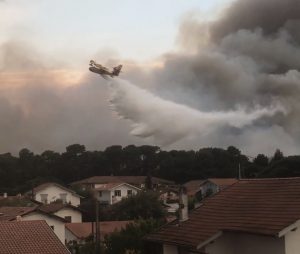 A ‘natural’ disaster or an inevitable ‘fire event’?
A ‘natural’ disaster or an inevitable ‘fire event’?
It really is time to take a look at our lifestyle values. We’re, for the most part, born with everything we need for life and for living. Our most valuable assets are with out a doubt our health and our natural habitat. What if one day we wake up to realize that having more money than you can spend in a lifetime, working hard and neglecting the environment is to the detriment of your health and perhaps is not the answer to longevity and happiness?
Like everything else, life is a balance and its time we worked out how to balance our way forwards in sync with what’s left of the natural world around us before its too late.
What if we had the technology to rehydrate the planet? What if the seas were rising (they are), but we could desalinate the sea water (technology available) and using natural energy sources we could pump this water (technology available) to land which used to be fertile and simply let it flow. Let it follow the path of the now dry river bed once more.
What if instead of spending trillions on inhabiting distant dead dried out planets, that wealth and knowledge was concentrated on hydrating and rewilding our own planet?
Imagine the carbon capture effect of a rehydrated and fertile green planet. Re wilding lands where people could live again, moving back to their homelands to learn to live with nature all over again.
Our cities don’t have to be sterile concrete deserts, they can be green shady places. The ground doesn’t have to be just solid impenetrable concrete, it could also be green space surrounded by lush oxygenating plants.
Some of these changes could be quickly accomplished, re wilding our planet could and should be a global experience and the impact could be massive.
Green spaces are our future, our natural carbon capture society is just around the corner, but we need to make it so. The powers that be aren’t going to do it unless we demand it and there are many voices and organizations that are asking for change and waiting for our input. We all have a voice and these organizations and our planet needs ours.
Changing our ways, doesn’t necessarily mean stopping everything that we do. We have the means to change how we travel, and live in balance with nature.
I rely on people travelling to visit, venture amongst and experience the amazing wonders of our Natural World.
The ‘irony’ of this statement, when balanced with the transformation I see on a daily basis within this ‘Natural World’ is not lost on me. But, I try to use these incredible moments, surrounded by ‘Nature’ to educate and inspire those with whom I share these sacred places. It is my hope that The power of ‘Nature’ will work its magic on them and that these experiences will change their lives for the better. Powerful experiences like these stay with us forever, life changing experiences that are taken home, passed on and shared. Without us seeing the beauty and feeling the power of nature, without the personal experience, without us seeing the destruction, with out seeing all of this with our own eyes the urgency, the belief, the need is second hand. Through these unique experiences the importance of the power of Nature bonds to the human experience.
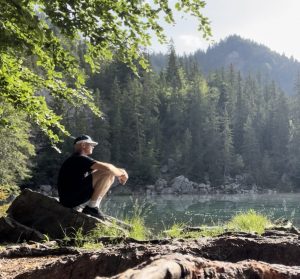 Finding balance with nature and ‘rewilding’ our planet is our future
Finding balance with nature and ‘rewilding’ our planet is our future
Stand in nature and rewild your self space, see it for yourself, see the changes and let it shock the fck out of you, it’s a powerful thing!
I am also changing my habits, I try to travel less, journey less far and stay in place longer. I prefer to hike to a summit and enjoy the experience of being surrounded by nature, both on the way up and on the way down, far more than riding the lifts and standing in queues, surrounded by artificial noise and too many people. Home life is simple and organic, we live, we grow, we play. Health and happiness are key values and without natures balance these values don’t exist.
I’m trying to balance my contributions in a positive and creative fashion and I’m learning as I go.
I know my future exists within the balance of Nature, and I must find my balance with nature.
I know our Future exists within the balance of Nature, and we must find our balance with nature.
It seems we’ve got plenty to do and there’s plenty we can do.
Start by joining a local, national or/and international climate action group, keep up with the latest developments and make your voice heard. Demand change from your local politicians and government representatives, voice your concerns, they work for you. If they don’t act, don’t vote them in.
Vote for the planet, vote for the future and make it re-wilder!

